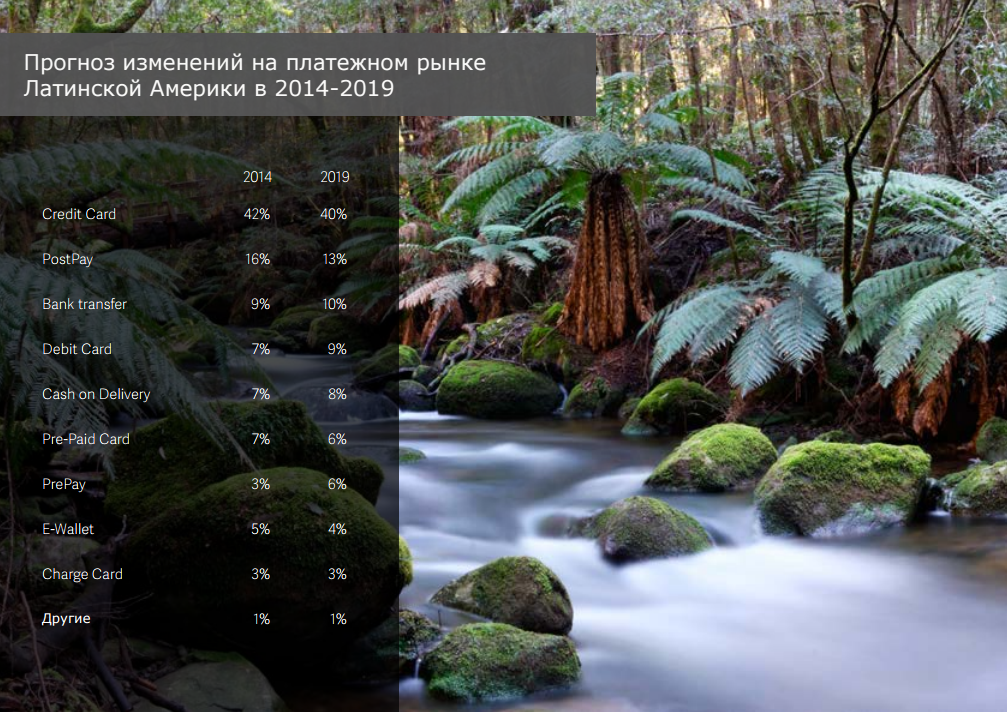Key trends in the global electronic payment market. Part 1
 Debugged and satisfying the needs of customers, the online payment process is more relevant than ever. However, when entering new markets with your project, it may be difficult to choose from more than 300 existing payment schemes today. The global payments market is growing rapidly: in 2015, it reached $ 1.66 trillion, an increase of 14% compared with 2014. According to Worldpay, in its new study, alternative payment methods, such as e-wallets, bypassed plastic cards, becoming the most popular online payment method.
Debugged and satisfying the needs of customers, the online payment process is more relevant than ever. However, when entering new markets with your project, it may be difficult to choose from more than 300 existing payment schemes today. The global payments market is growing rapidly: in 2015, it reached $ 1.66 trillion, an increase of 14% compared with 2014. According to Worldpay, in its new study, alternative payment methods, such as e-wallets, bypassed plastic cards, becoming the most popular online payment method.Until now, PayPal, AliPay, Yandex.Money, and their analogs were the most popular way to use among alternative types of payment. Worldpay expects that by 2019 the volume of payments through digital wallets will amount to $ 647 billion or 27% of the total market revenue, while credit cards - $ 577 billion or 24% of the market. Debit cards will become the third most popular way.
Under the cut, the first part of the Worldpay study “ Trends in the global payments market ”, which presents statistical and forecast data on e-commerce markets in various regions of the world. But first I propose to dwell on the definitions of various methods of payment.
Definitions of payment methods
ASO . Alternative means payment methods that do not require the direct use of plastic or virtual cards based on global payment systems, such as Visa, MasterCard or American Express.
')
Real-Time Bank Transfers (real-time bank transfer). Customers pay for goods using the online banking service. During payment, they are either redirected to the payment page of their bank, or they choose their bank in the list of service provider or seller of goods. Payment authorization in most cases occurs instantly. Examples: iDeal , Sofort Banking , eNets, Przelewy24 , Safetypay .
Offline Bank Transfers (bank transfer with an auxiliary code). During the payment process, customers receive an auxiliary code. Knowing it, they can enter the online banking service at any convenient time and complete the payment operation with it. Payment authorization occurs only at the time of completion of the operation. Examples: Dineromail , SafetyPay .
Bank transfers account for $ 212 billion or 11.1% of the e-commerce market in 2014. The segment size by 2019 is estimated at $ 283 billion / 11.7% of the market.
Cash on Delivery (cash on delivery). Payment for goods is made at the time of delivery. The popularity of the method is growing in India and some countries of Southeast Asia. However, due to the local specifics of different countries and sellers, cash on delivery as a method of payment is not suitable for each of them. Its disadvantage is also the impossibility of delivery to other countries and regions, therefore, growth on a global scale is out of the question. Examples: There is a typical delivery method for many vendors and delivery services.
The size of this segment at the end of 2014 amounted to $ 124 billion or 6.5% of the e-commerce market. The forecast value for 2019 is $ 165 billion / 6.8%.
Direct Debits . It is used in cases when the client is required to pay regularly, with a certain frequency. This method is well suited for predictable payments, such as utility bills or subscriptions to goods or services. The customer can usually make a refund.
Examples: SEPA DD , ELV .
The segment size in 2014 is $ 5 billion, which corresponds to 0.3% of the total e-commerce market, and about $ 13 billion / 0.6% by 2019 (the forecast value).
EInvoices (accounts). Using invoices allows customers to pay for goods upon delivery. You can pay for the purchase both at the time of order confirmation, and within a few weeks thereafter. For the buyer, the process is very simple: he just needs to enter the email address and the postal code of the recipient. However, to avoid entering the details of a bank account or card will not work, because in the end, the payment is made with their help.
Examples: Klarna , AfterPay .
At the end of 2014, the size of this segment was $ 3 billion, the percentage of the e-commerce market was 0.1%. By 2019, the market share could reach $ 8 billion / 0.3%.
eWallets (e-wallets). Simple, convenient and secure payment method, which is becoming increasingly popular in the market. Payment for purchases can be made using the amount available on the account of the wallet, as well as using other sources of funds associated with it. Examples: Alipay , Tenpay , PayPal , Qiwi , Yandex.Money .
According to the results of 2014, the market share is one of the most significant - 21.7% or $ 417 billion. According to forecasts, in 2019 e-wallets will occupy a leading position in the e-commerce market, their share will be 27.6%, and the total amount - $ 668 billion.
PostPay (postpay). The customer chooses the product in the online store and pays for it after placing the order in stores, retail outlets, bank branches or other places in the affiliate program. The delay between order confirmation and actual payment makes this method inconvenient for selling a number of product categories.
Examples: Konbini, Boleto Bancario .
This segment owns 0.9% of the payments market, which corresponds to $ 18 billion (2014). By 2019, a slight increase is possible to $ 25 billion / 1.0%.
PrePay (prepay services). To purchase, a customer must purchase a PrePay card or voucher calculated for a certain amount. Cards and vouchers are marked with a PIN code and contain a small amount of funds (from $ 5 to $ 100). They can be formed, forming a total balance on the account. To make a payment, the cardholder only needs to enter a PIN code when paying for the goods. Examples: paysafecard , NeoSurf .
The segment size is $ 55 billion, the percentage of the e-commerce market is 2.9% (2014). By 2019, the share of prepaid services will be $ 122 billion / 5.0% (predicted value).
Pre-Paid Cards (prepaid card). Pre-Paid cards work on the basis of payment systems such as Visa or MasterCard. Just as in the case of debit and credit cards, Pre-paid cards allow you to make purchases or withdraw cash, but without the ability to exceed the amount available on the card at the time of the transaction. The key difference from a debit card is that the Pre-paid card is not tied to a customer’s bank or deposit account. It also lacks many other benefits that debit card holders receive. Banks often offer such cards to young people, customers who do not use other banking services and have bad credit history.
Segment size in 2014 - $ 45 billion, the percentage of the e-commerce market - 2.4%. In 2019, a slight decrease in the size of this segment is expected, to $ 43 billion / 1.8%.
Debit Cards (debit cards). When making a payment using a debit card, the funds are debited from the personal bank account to which it is linked. If the amount of the debited amount exceeds the funds available in the account, the operation is canceled. However, unlike the Pre-paid card, the bank may allow the holder to exceed the card limit (overdraft). Also called an asset card in the United States or a payment card in the UK.
The volume of payment transactions on debit cards in 2014 amounted to $ 387 or 20.1% of the total payments. Thus, debit cards ranked third in the ranking of the most popular payment methods. However, by 2019, their market share will drop to 17.2%, despite the fact that in dollar terms, the segment will reach $ 416 billion.
Credit Cards (credit cards). The credit card holder gets the right to use a certain amount of funds given to him by a credit card issuer. The client undertakes to return part of the amount spent together with the interest and other possible commissions within the same accounting period (30 days). The rest of the debt can be paid immediately or after a time, at the request of the client. In the latter case, the payment of the balance is transferred to the next billing period. The issuer can be either a bank or a store or service provider (for example, an airline).
The segment size at the end of 2014 was $ 577 billion. The share in the e-commerce market is 29.9%, the largest among other payment instruments. According to forecasts, by 2019 credit cards will give way to e-wallets and will occupy 24.9% of the e-commerce market, the total amount of payments on credit cards will reach $ 603 billion.
Charge Cards (payment card). A variety of credit card. The difference is that in the case of Charge Cards, all debts (the sum of all payments made) must be repaid within one billing period (30 days) without transferring any part of it to the next period. Example: most American Express cards.
The segment size at the end of 2014 was $ 59 billion, the share of the e-commerce market was 3.1%. By 2019, the volume of payments on settlement cards and their percentage share in the market will decrease to $ 57 billion / 2.3%.
Other payment methods . This includes methods of payment for services using a mobile number, cryptocurrency and other young and promising technologies. Examples: Bitcoin, Zong , BOKU .
The segment size at the end of 2014 amounted to $ 20 billion / 1.0% of the payments market. By 2019, its share may be slightly reduced - to $ 19 billion / 0.9%.







In the next part, we will focus on the Russian e-commerce market and describe what alternative payment methods Russians prefer, what volumes the Russian e-commerce market has reached, what will happen to it and other markets in the coming years, and much more. Subscribe to our blog, and if you need to organize payment acceptance by card or electronic money, contact us at PayOnline , we will provide a quality payment solution for your business.
Source: https://habr.com/ru/post/390633/
All Articles